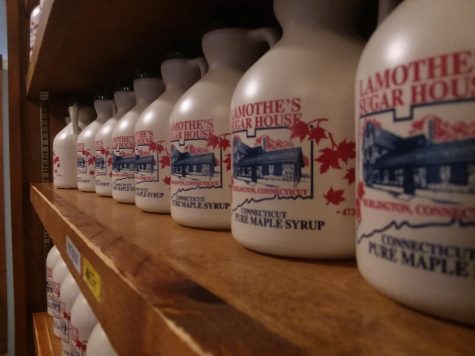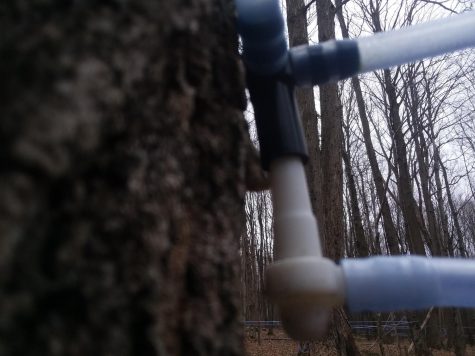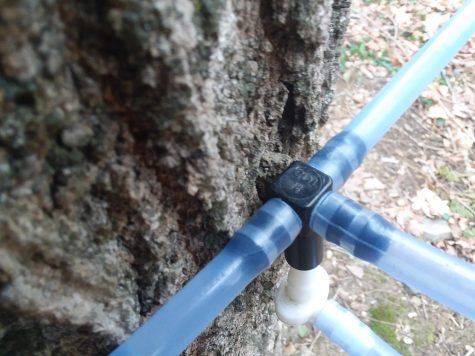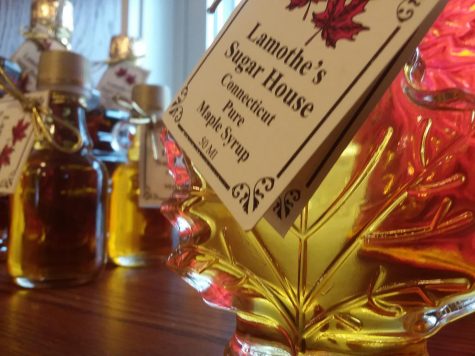Inside The Taps: The Environmental Ties of Lamothe’s Sugar House
March 11, 2020

Across the cold forests and hills of Connecticut, February settles in. You may know this month for skiing and Valentine’s Day, but this is a hugely important time of the year for the maple industry – sugaring season, when groups of maple trees, called sugarbushes, are tapped for their precious sap. There are many, many factors at play, and for Lamothe’s Sugar House in Burlington, the climate is key to the tapping process. We are going to dive into a journey into the tapping process – how the environment affects maple syrup, and in turn, how Mr. Robert Lamothe returns the favor to keep his trees flourishing.
Lamothe’s Sugar House was founded in 1971, when Mr. Lamothe’s brother, Leonard, found some taps and the two began to research the tapping process. Forty-nine years later, they are making, according to critics and travelers alike, some of the best syrup in the county from their location at 89 Stone Road. When it comes to tapping the trees, the environment is everything. In fact, now is the best time for maple syrup for a variety of reasons.

In February, there are freezing cold nights and thawing, higher-temperature days. When it is about 20 degrees Fahrenheit at night and 40 during the day, the cycle causes carbon dioxide to form in the tree.
“When the ice thaws, the carbon dioxide pushes the sap out of the tree,” says Mr. Lamothe, who has become a master of the process since he founded the Sugar House. “That’s when we collect the sap.”
Of course, for the sap to come out of the maple tree, a hole needs to be drilled. This may sound bad, but Lamothe’s part in keeping the environment healthy and ensuring that the trees are around for years to come is making sure that the nutrients don’t drain from the drilled wound, which could mean death for the maple. As Mr. Lamothe states: “If you over tap a tree, it will die.”
A 5/16th-size tap, about the size of a ping-pong ball, is used to prevent widening of the hole, and is one of the primary ways Lamothe’s Sugar house helps the environment.
Furthermore, when you tap a maple tree, you take 2 percent of the nutrients inside of it for use in maple syrup. Lamothe’s Sugar House cannot take more because the tree needs the rest of its nutrients to grow leaves. That’s why they are forced to stop tapping when the trees begin to grow buds, so they can resume their life cycle of drawing in sunlight via leaves throughout the seasons.

But larger factors are at play. Climate change is rearing its head across the world, and the maple industry is greatly affected. Winter patterns are changing and the areas around New England are getting gradually warmer.
“What we’re seeing this year is that this winter hasn’t been that severe and chilly,” says Lamothe. “We had more colder weather around Thanksgiving than now in February. We need more snow.”
Whether you love snow or can’t wait until summer, he’s right. At the Sugar House on Feb. 2, Lamothe anticipated the tapping process would begin about a week or two later. You may think that it isn’t much of a time frame, but it’s everything to the Sugar House. According to Lamothe, if they had started on that warmer-than-average, early February day, the outcome would drastically change: “We’d lose a third of our crop.” A third of the crop is about 21,500 gallons of sap, which is 500 gallons of syrup – and $36,000 dollars. Sooner or later, Lamothe adds, maple syrup will not be made in Connecticut. Or someday even Vermont, due to the ever warming-climate.
Tapping is not the only part of making maple syrup, and Lamothe’s Sugar House also accounts for its carbon footprint in the sugaring process. A reverse osmosis machine filters out the water in the sap, and  it has reduced greenhouse emissions by saving the water and converting it into steam. In fact, 80 percent of the water in the sap is filtrated out. In addition, in 1997, Mr. Lamothe added a UV light machine to help destroy bacteria.
it has reduced greenhouse emissions by saving the water and converting it into steam. In fact, 80 percent of the water in the sap is filtrated out. In addition, in 1997, Mr. Lamothe added a UV light machine to help destroy bacteria.
“It’s more safe when it’s early and efficient,” he said, showing the sleek cylinder of the gadget.
Over the years, Lamothe’s Sugar House has grappled with the changing climate and continued to make its process better and better for the environment and the various maple products they create – from maple syrup to soap to candy, and even maple pancake mix. It certainly looks like this year will herald more great maple syrup from the Sugar House, and you can thank the amazing process of creating maple syrup, from the tapping of the trees to the bottling and putting out on the shelf for all to enjoy. In fact, tapping season has officially begun at the time of this publication, and Lamothe’s is open for tours if you want to learn more about the tapping and sugaring process. If you want to visit and buy an organic Connecticut-made maple product, consider stopping by

Lamothe’s hours are: Monday to Thursday, 10 a.m. to 6 p.m., Friday and Saturday from 10 a.m. to 5 p.m., and Sunday from noon to 5 p.m.
Priscilla Galvin • Apr 10, 2020 at 8:09 am
Fascinating article full of information. I have to admit I was surprised by the effect of the changing climate on the maple trees and the ability to collect the sap. That is very disappointing news. Finding out all the ramifications of climate change how affects all aspects of life on earth from land to sea. It seems that every day we discover something new.
Thank you Kyle
Priscilla Galvin